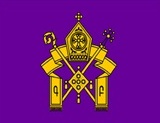ARMENIAN HOLY APOSTOLIC CHURCH

In the beginning was the Word, and the Word was with God, and the Word was God.
He was with God in the beginning.
Bible, John 1
The Armenian Holy Apostolic Church is one of the world’s oldest chuches and has been an inseparable part of Christ’s “One, Holy, Universal and Apostolic” Church throughout its existence.
The Armenian Church was named Apostolic in honor of Apostles Saint Thaddeus and Saint Bartholomew, who were the first to spread Christianity in Armenia. Armenia is the first country that adopted Christianity as the state religion of the Kingdom of Great Hayk during the reign of Armenian King Trdat III in 301.
The faith in and doctrine of the Armenian Church are based on the Holy Bible, the Sacred Tradition, the Councils of Nicaea (325), Constantinople (381) and Yepesos (431), the councils of the Armenian Church, as well as the rules and teachings of archimandrites and the fathers of the Church.
The Armenian Church has also considered the protection of faith, rituals, worship and the independence of the church as the most important factor for the Armenian people and their national preservation. After the Council of Chalcedon in 451, Byzantine made an attempt to serve the issues related to the church and faith against Christian nations in the East in order to deprive them of their faith and national and cultural identity.
The Chalcedonian Creed of “Two Natures of Christ” laid the foundation for disputes between the Byzantine and Eastern Churches and becmae a reason for the split of the Universal Church.
The Armenian Church rejected the Council of Chaldecon since it went against the interests for preservation of the Armenian national identity, as well as the Armenians’ perceptions of theology and the aspirations for preservation of the Church’s independence, accepting the Humane and Divine Natures of Christ as coexisting.
The First Catholicos of All Armenians, Saint Gregory the Illuminator established the hierarchy of the Armenian Church, staying true to the principles of the administrative system of Armenia.
The Armenian Holy Apostolic Church, as a national Church with the Catholicosate of All Armenians (Mother See of Holy Etchmiadzin), the Catholicosate of the Great House of Cilicia, the Armenian Patriarchates of Jerusalem and Constantinople and the Hierarchical Sees, has a special mission in the spiritual life of all Armenians, the development of the nation and its culture and the preservation of the national identity. His Holiness Karekin II, Supreme Patriarch and Catholicos of All Armenians is elected the leader of the Church.
The Armenian Apostolic Church sparked great interest with the ecumenical movement that began in the 20th century and gained momentum in the second half of the century, starting out with the status of an observer. Starting from 1962, the Church, under the direction of the Mother See of Holy Etchmiadzin, became an official member of the World Council of Churches (WCC), and starting from 1977, an official member of the Conference of Churches in Europe (CCE), going on to become a member of regional, sub-regional, national, inter-ecclesiastical and other ecumenical organizations.
The following are the Delegations and Dioceses of the Armenian Holy Apostolic Church:
Patriarchal Delegation of Western Europe, Patriarchal Delegation of Central Europe, Patriarchal Delegation of India and the Far East (http://www.araratian-tem.am), the Shirak Diocese, the Syunyats Diocese, the Gugarats Diocese, the Aragatsotn Diocese, the Artik Diocese, the Gegharkunyats Diocese, the Armavir Diocese, the Kotayk Diocese, the Artsakh Diocese, the Georgian-Armenian Diocese, the Armenian Diocese of Nor Nakhichevan and Russia, the Armenian Diocese of Southern Russia, the Armenian Diocese of Ukraine, the Armenian Diocese of France, the Armenian Diocese of Great Britain, the Armenian Diocese of Greece, the Armenian Diocese of Romania and Bulgaria, the Armenian Diocese of Germany, the Armenian Diocese of Switzerland, the Armenian Diocese of Canada, the U.S. Eastern Diocese, the U.S. Western Diocese, the Armenian Diocese of Argentina, the Armenian Diocese of Bulgaria, the Armenian Diocese of Uruguay, the Armenian Diocese of Egypt, the Armenian Diocese of Damascus, the Armenian Diocese of Iraq and the Armenian Diocese of Australia and New Zealand.
Today, the Church stays true to its mission and continues to carry out its activities for reinforcement of Armenian statehood, as well as preservation and radicalization of the Armenian identity.




 Արևելահայերեն
Արևելահայերեն Արևմտահայերեն
Արևմտահայերեն Русский
Русский






